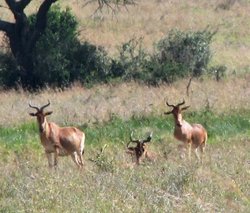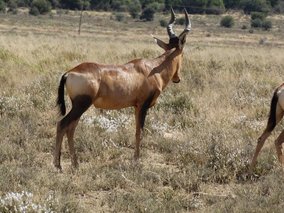How Many Species of Wild Ruminants Are There in Africa?


Two hartebeest species: kongoni (Alcelaphus cokii) in Nairobi National Park, Kenya, left; and Red Hartebeest
(Alcelaphus caama) in Mountain Zebra National Park, South Africa. Photo Credit: Colin Groves
By Colin Groves
It seems extraordinary, but the taxonomy of the wild ruminants of Africa basically derives from a three-volume series published in 1913-141, modified by a book published in 19532. Both were the product of what was then called the British Museum (Natural History) (now called simply the Natural History Museum). The 1913-14 volumes, by Richard Lydekker, laid down the basics; the 1953 book, by Sir John Ellerman and his colleagues, said in effect, usually rather cavalierly and with little or no extra evidence, “Lydekker recognized too many species of ruminants in Africa: let us lump them so that we have fewer”.
Wildlife managers and conservationists have grown up with this taxonomy and have seemed to feel comfortable with it. Geneticists have begun to work widely on Africa’s large mammals, and in the main take Ellerman et al.’s taxonomy for granted.
Dr Peter Grubb and I, from about 1970 onwards, began to look again at exactly how many species of African ruminants there really are (He was first in Ghana, then in England, I was in Australia: but we corresponded back and forth, and I would visit England every couple of years). At first, we accepted the lumpers’ classification, that there were about 50-60 different species of bovids (antelopes, buffaloes, wild sheep and goats), plus giraffes and mouse deer, in Africa, and worked on the supposed subspecies, suggesting that there were some that have not been recognized before, while others were not valid. Gradually, we began to look with different eyes: was it correct to lump the small red forest buffaloes together with the big black Cape buffalo in a single species, for example? Then, in 2003, Peter came across a rather startling paper by Fenton (“Woody”) Cotterill and could not wait for my next visit to England to tell me about it: “Cotterill has described a new species of tsessebe!” This resonated with me, because, in a book I published in 20013, I had already concluded that too few species of primates had previously been recognized – why not the same with antelopes? We looked again at our own work on antelopes and buffaloes and began to plan further taxonomic work. Alas, in 2006 Peter died. I inherited his notes, papers and unpublished manuscripts, and used them to construct a new book, which was published in our joint names in 20114. We suggested that were 186 species of bovids in Africa (probably more, because we had found a few specimens that seemed different from anything that had hitherto been described) and eight species of giraffes – although still only the one species of mouse deer.
The reaction to our new book was very mixed. Some embraced it enthusiastically, but in other quarters the reaction was hostile, particularly from those very wildlife managers and conservationists that we had hoped to influence. I can think of no real reason for the hostility other than that people were comfortable with the time-honored but incorrect arrangement, and I suppose recognizing at least three times as many species as before would be too much of a feat of memory!
What does it matter, anyway?
We live during a conservation crisis. Wild animals are threatened by hunting, by habitat destruction, by climate change, and by the runaway increase of the human population. How can we protect them all? The first thing is, of course, to find out how many species there are – how many species do we need to protect, and where do they live?
Consider the hartebeests (genus Alcelaphus). The IUCN Red List recognizes only one species, Alcelaphus buselephus, which it classifies as Least Concern, but it admits that there are several distinctive forms, which they classify a subspecies, within this one species. Groves & Grubb (2011) recognized eight species (one of them extinct in the early 20th century); these differ in shape of horns, color and color pattern, and degrees of sexual dimorphism, and there seemed to be some differences in reproductive biology as well. Instead of a single species of Least Concern, there would be eight species of different levels of conservation concern: one of them, Alcelaphus caama, the Red Hartebeest of southern Africa, is increasing in number, but all the others are declining, in fact one of them (Alcelaphus tora of the Ethiopia-Sudan border region) could not be found in a search 10 years ago and may now be extinct. In recognizing more than just the one species, we discovered a more realistic scenario – all but one of the extant species are in fact Endangered.
Consider the greater kudu. A big, magnificent antelope, grey with white stripes, the male with huge spiral horns. Distributed sporadically from the Cape north to Eritrea, then west to Chad, all Kudus have traditionally been considered as one species, once again deemed by IUCN to be Least Concern. Groves & Grubb (2011) argued that there are in fact four different species: Strepsiceros from the southern Cape region of South Africa, the symbol of South Africa National Parks; Strepsiceros zambeziensis, which ranges from the northern part of South Africa through to Tanzania; Strepsiceros chora, which lives sporadically in northern Kenya through Ethiopia into Eritrea and eastern Sudan; and Strepsiceros cottoni, from Chad. Although the two-southern species are indeed still numerous and widespread, the two-northern species (which are very different in appearance and size from the two southern ones) are poorly known and are not at all likely to be Least Concern, but to my knowledge nobody has assessed them.
And consider the giraffe. IUCN recognizes just one species of giraffe, Giraffa camelopardalis, which it deems Vulnerable. In this case, genetic research concluded that there are certainly several species, not just one, and on this basis Groves & Grubb (2011) proposed to recognise eight species, distinguished by their blotches, the development of multiple horns, and other characters. Two of these are surely Endangered. One of them, Giraffa peralta, which has been called the White Giraffe, used to be widespread throughout West Africa, but is now restricted to a few hundred in southern Niger. Fortunately, the local people have taken it upon themselves to preserve this population, and for the moment it is increasing – but just a single population! Not so closely monitored is the Kordofan giraffe, Giraffa antiquorum, which is or was found from the west bank of the Nile west as far as Lake Chad; all is known is that they still exist in the DRC and in Chad.
The message of this is clear: don’t ignore the advances in modern biological understanding. We must recognize what we have, or we will lose it. Would the tora hartebeest have been allowed to vanish if it had been realized that it is a distinct species? Do the two northern kudu species need to be surveyed and awarded special protection, or is it enough to say, “kudus are not endangered because they are plentiful in South Africa”? And the Kordofan giraffe: because they have been deemed to be part of all-purpose “giraffe” they have not been specially monitored, and we simply do not know whether their population is decreasing, or stable.
The philosopher of science Thomas Kuhn5 said that science advances by paradigm shifts, and that the old ways of thinking typically do not disappear by force of evidence alone, but because their practitioners retire or die. I would hate to think that this is true of our hard-working wildlife managers and conservation practitioners; but it remains true that, unless there really is a paradigm shift, we stand to lose a great deal of the world’s precious biodiversity.
References
1 Lydekker, R. 1913-14. Catalogue of Ungulate Mammals in the British Museum (Natural History), volumes 1-3 (volumes 2 and 3 were co-authored by G. Blaine; two further volumes dealt with other hoofed mammals). London: British Museum Trustees.
2 Ellerman, J.R., Morrison Scott, T.C.S.& Hayman, R.W. 1953. Southern African Mammals 1758-1951: A Reclassification. London: British Museum Trustees.
3 Groves, C. 2001. Primate Taxonomy. Washington: Smithsonian Institution Press.
4 Groves, C.& Grubb, P.2011. Ungulate Taxonomy. Baltimore: Johns Hopkins University Press.
5 Kuhn, T. 1962. The Structure of Scientific Revolutions. Chicago University Press.